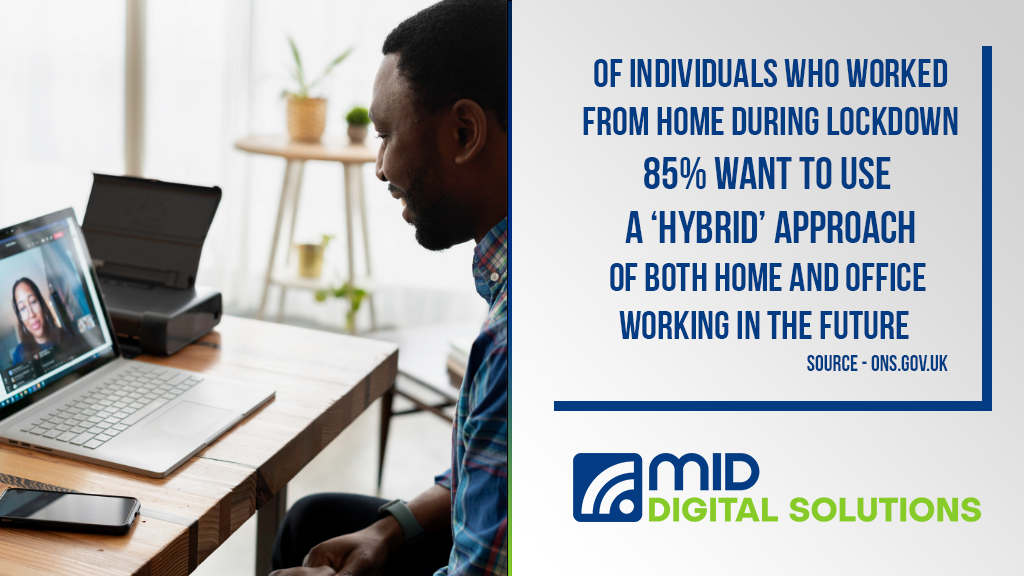

UK businesses adjusted quickly to keep their operations running during the first national lockdown. Businesses achieved continuity at times through simply adapting their existing technology solutions and making use of free digital services wherever possible.
But as we progress now into more permanent ways of working in a post-Covid landscape, businesses must adjust their technology stack to not only survive the new conditions, but to thrive.
What is ‘Hybrid working’?
‘Hybrid working’ describes a working environment in which an organisation’s employees split their work between office-based locations and home or other remote locations. Several publicly visible, global businesses have announced their intention to continue this indefinitely, allowing employees to work how and where they choose, including BP, Twitter, Capital One and Microsoft.
While there are many benefits, many businesses are now discovering that the transition to hybrid work isn’t without challenges. Continuing to utilise the existing technology stack that they already had in place may not be sufficient to provide a seamless experience when some employees are in the office, and some are remote.
Commercial benefits
Hybrid working presents organisations with new challenges, but it also offers them opportunities that may not have been considered viable in more traditional office-based work environments, also encouraging the adoption of cloud services as part of accelerated digital transformation projects.
Looking at it from the point of view of a business, hybrid working creates an environment in which organisations can potentially get the most out of their workforce. Every employee is working in their preferred way, in their chosen environment. What we’re seeing is businesses looking at the technology solutions they need to enable this.
From a commercial standpoint, the introduction of the cloud-based technology solutions required for effective hybrid working can actually save cost and increase efficiency if correctly implemented. Reducing on-site hardware for IT and telecommunications and switching to monthly subscription-based services will allow a transition from CapEx to OpEx, meaning no upfront expenditure and improved cashflow, while compliance, resilience and scalability are improved.
As well as the improved agility, it is possible that hybrid working can reduce costs in other ways, perhaps through a lower demand for office space, or through simplifying IT requirements for a business. While it may seem complex to have remote workers utilising cloud-based tools, often your provider should be able to provide all the necessary training for your employees, meanwhile the responsibility for hosting, servicing, and upgrading your services will also fall to the vendor.


Employee benefits
Employees of many businesses have now either worked in part or entirely from home for 12-18 months. It would be easy to assume the return to office will be painless and simple, but in some cases, workers have become used to their new routines, and the benefits brought about by working in such a way.
Saved costs, and the time gained by removing the need to commute, leading in many cases to a better work–life balance through allowing more time for family, friends, and exercise are the most tangible benefit of remote working. However, additionally, many workers cite a greater ability to focus with fewer distractions, IT upskilling and higher levels of motivation as further benefits.
A good hybrid working policy will make it seamless for employees who will likely benefit from these benefits, and for whom a role is suitable for remote work at times. However it is also essential to consider those who are keen to return to the office. Ultimately this will lead to higher levels of employee job satisfaction and reduced absence rates.
Lastly, a hybrid working policy should allow businesses attract new talent, driven to find an employer with flexible working options, or who may otherwise have been geographically unsuitable, or perhaps would not have been able to commit to a full-time commute to an office location.
Challenges to consider
While there are many benefits associated with a hybrid working policy, there are several decisions businesses need to make before implementing. These are everything from how to overcome legal and HR challenges, through to technology related considerations.
From a legal standpoint, if a business is considering formally introducing a policy, there may be contractual updates required for updated policies including, for example, managing travelling and other expenses, IT usage, homeworking, and data protection.
In more human terms there must be thought given to how new policies affect the wellbeing of the most important resource within a business – employees. It is essential that organisations build a culture that is suitable for hybrid working. Managers should develop skills to ensure effective communication, performance management, team and relationship building and collaboration in hybrid teams, while training on any new systems is essential.
With that in mind, how does your technology stack encourage relationship building and collaboration? Does your business use instant messaging or collaboration tools such as Teams to promote ‘ad-hoc’ discussion, and if so, are they setup for online meetings by default and do they also allow employees to make external phone calls from the same system? Considering a unified communications strategy could be central to ensuring many other challenges are easily overcome.
One final challenge for operating hybrid working practices is security. Once outside of a well-protected office network, and instead reliant on their own connectivity, employee devices could be vulnerable to security breaches. This can be easily overcome by implementing suitable IT and mobile policies, and with the implementation of threat defence software, but is important to consider.
Conclusion
Hybrid working can bring commercial and employee benefits when implemented well. Reduced office space and demands on IT and other services can save businesses costs, while cloud migration increases efficiency and agility. Meanwhile reduced time commuting, better work-life balance and increased flexibility can improve well-being for staff.
However, in a hybrid work environment, businesses continuing to rely on their existing technology stacks and business policies may struggle to adapt. Employees need to be able to work seamlessly between workplace and home, and there needs to be ease of connectivity between people in the office and those working remotely. Older solutions may not translate seamlessly into hybrid work environments, while business culture may need to adjust to maximise the new opportunity.
To learn more about how we can support your business in transitioning to hybrid working, here’s how to get in touch
Email us @
hello@middigitalsolutions.com
Call us on
0161 974 6838
Or find us on our YouTube Page
www.youtube.com/middigitalsolutions

